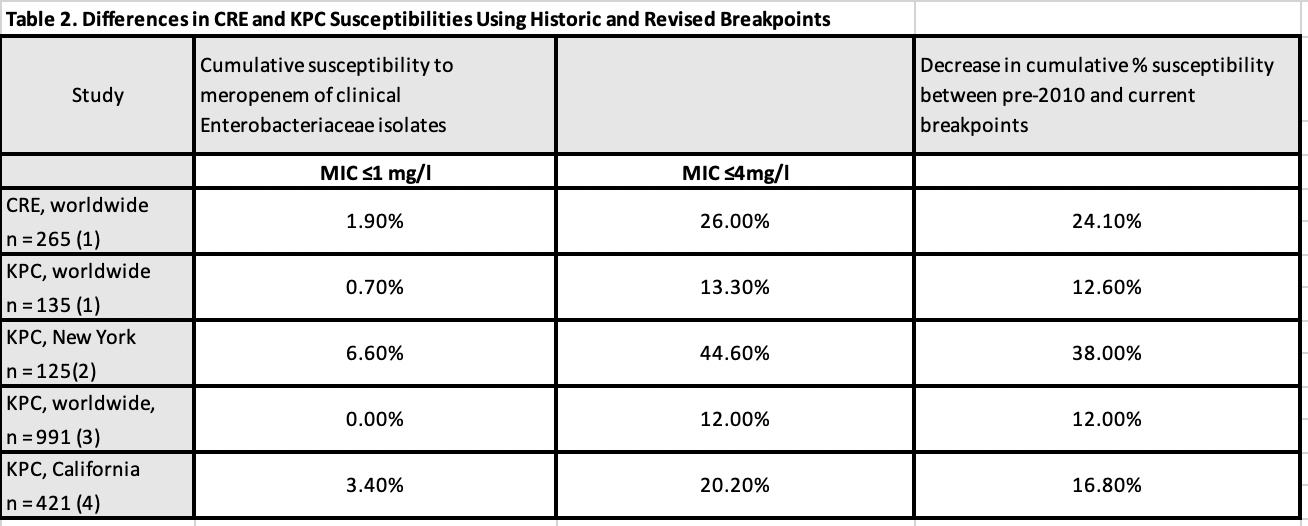The Importance of Maintaining Antibiotic Breakpoints
Laboratories that use revised carbapenem breakpoints detect significantly more carbapenem-resistant Enterobacteriaceae than laboratories that use historical ones.
Antibiotic resistance is a major health crisis. Antibiotic stewardship programs (ASP) mandated by the Joint Commission are critical tools in managing this resistance, but an important component of ASP is the provision and referral of timely antibiograms. These data sets enable clinicians to empirically prescribe antibiotics appropriately. Development of antibiograms is dependent on accurate and reproducible susceptibility testing using current and relevant antibiotic breakpoints.
In the United States, the development of breakpoints is performed by standards development organizations (SDOs), such as the US Food and Drug Administration and Clinical and Laboratory Standards Institute (CLSI). These SDOs use new tools developed in the field of pharmacokinetics and pharmacodynamics (PK/PD), the relationship between breakpoints, achievable drug concentrations with approved on-label doses, and clinical outcomes to establish breakpoints. Using the new data, breakpoints are regularly reviewed and updated.
The recognition of new bacterial resistance mechanisms in 2010 in the Enterobacteriales (formerly, Enterobacteriaceae), such as Klebsiella pneumoniae, caused the CLSI to re-assess the PK/PD of carbapenems, such as ertapenem, imipenem, and meropenem. Anomalies between 2010 breakpoints and the production of carbapenemases were noted, leading to minimum inhibitory concentrations (MICs) of some of these carbapenemase-producing bacteria to be reported in the susceptible range.

The historic (pre-2010) and revised breakpoints are shown in Table 1a. It was shown that use of historic breakpoints led to “false susceptibility.” Laboratories that use revised carbapenem breakpoints detect significantly more carbapenem-resistant Enterobacteriaceae than laboratories that use historical ones. Five studies show a decrease in cumulative susceptibility between pre-2010 and current breakpoints (Table 2).
Critically, it has been estimated that around a third of laboratories do not implement the current breakpoints for carbapenems and Enterobacteriaceae. Moreover, some laboratories took more than 4 years to implement the CLSI updates. Indeed, there is an assumption among those automated systems are automatically updated by the manufacturer, which is not always the case.

Significantly, there are 3 major consequences of failing to update breakpoints. Firstly, antibiograms based on pre-2010 breakpoints overcall susceptibility, making empiric therapy recommendations inaccurate. Secondly, many antibiotics are prescribed empirically based on antibiograms, which increases the risk of clinical failure when “falsely susceptible” antibiotics are prescribed. It has been shown that such inappropriate antibiotic therapy increases morbidity and mortality as demonstrated by longer length of hospitalization and ICU days, greater antibiotic days, and costs of therapy. Finally, and often overlooked, is the spread of resistant pathogens when infection prevention cannot identify emerging resistance trends; failure to identify these pathogens enables them to be disseminated throughout the hospital environment leading to colonization and infecting other patients.
Microbiologists may be aware of the breakpoint changes but unable to update them because they are tied to using their current automated devices. Equally, laboratories do not have adequate resources to verify the new breakpoints, often citing the lack of test strains. Resources are available for clinical laboratories to undertake the verification process; the CDC provides a 31-strain panel of characterized isolates.
Although carbapenem breakpoints were updated nearly a decade ago, the CLSI revised fluoroquinolone breakpoints for Enterobacteriales and Pseudomonas aeruginosa in January 2019. It is too early to predict the impact of these changes, but obviously these will negatively affect antibiogram susceptibilities of levofloxacin and ciprofloxacin.
As a key component of antibiotic stewardship, the antibiogram must be up-to-date and pharmacists should liaise with their laboratory regarding breakpoint changes. Inability to implement changes will perpetuate inaccurate reporting of susceptibility test results and expose patients to inappropriate antibiotic therapies.
